Major Shaitan Singh
SENIOR MEMBER

- Joined
- Dec 7, 2010
- Messages
- 3,550
- Reaction score
- 43
- Country
- Location
Dmitri Mironov (Butcher171), St. Petersburg, 2011 , the Registry of the Mi-28N - HAVOC-B Weatherproof night-day attack helicopter. In 1993, after the end of the first stage of state trials attack helicopter Mi-28A was obtained preliminary conclusion on the issue of the initial batch of helicopters equipped with complex equipment and weapons for use in day-limited and adverse weather conditions. However, MV Weinberg, who by that time chief designer "Mil. ML Mile ", has decided to discontinue the development of the Mi-28A at the final stage of state trials and concentrate all forces and financial opportunities for the development of a combat helicopter Mi-28N (" H "- a night) - ROC" Vanguard 2 "- around the clock and all-weather, with essentially a new integrated set of on-board equipment of the fifth generation.
Test . The first experimental helicopter Mi-28N was built in August 1996 and made its first flight 14 November 1997 (test pilot and navigator V.V.Yudin S.V.Nikulin), and on April 30, 1997 began to pass the factory flight tests. Four years later, the Mi-28N entered the state joint tests (2001). Given the high demand for military vehicles of this type, the command of the Russian Air Force in 2002, took the Mi-28N as the main combat helicopter promising future, without waiting for the completion of the test.In June 2005, the program has begun testing the second prototype prototype of the Mi-28N. March 4, 2006 after the successful completion of the first phase of the state joint tests the state commission chaired by Chief of the Russian Air Force, Army General V.S.Mihaylova issued a conclusion on the issue of the initial batch of Mi-28N. In May 2006, state tests to join the first serial Mi-28N board №32. State joint tests of the Mi-28N completed December 26, 2008 signing of the act on their end. At GSI participated 2 experienced and 7 pre helicopters. October 15, 2009 order of the President of the Russian Mi-28N officially adopted for use as the primary attack helicopter.
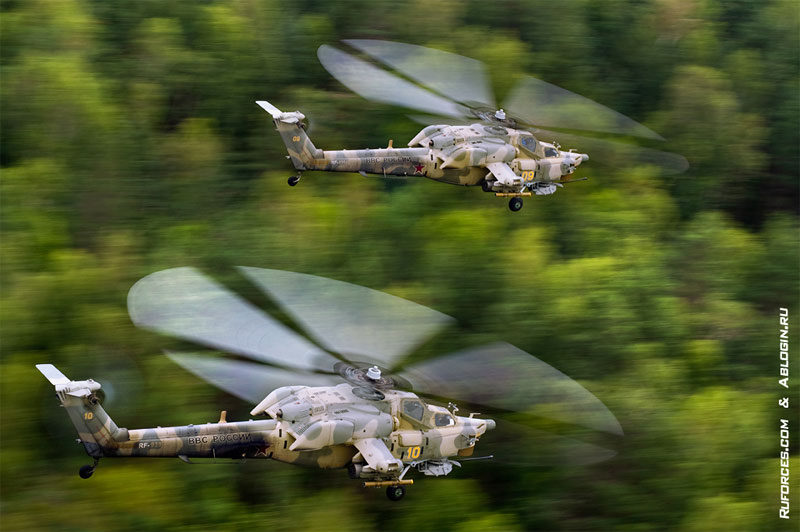
Mi-28N and 10 onboard №№09 yellow, summer 2012 (photo - A.Blogin, http://ruforces-com.livejournal.com ). Mi-28N built in 2012 at the airport by "Rostvertol" Rostov-on-Don, March 9, 2012 (photo - Michael Mizikaev, ✈ russianplanes.net ✈ наша авиация ). The first prototype of the Mi-28N - OP-1 helicopter, board №014 after modifications to the air show MAKS-2003 , 23.08.2003 (photo - Flavien Breitenmoser,http://www.airliners.net ). The Mi-28N - a prototype of the Mi-28NE participated in the demonstration flights in India at MAKS-2011 August 16-21, 2011 . (photo - VLAS, Отечественная военная техника (после 1945 г.) • Главная страница ).


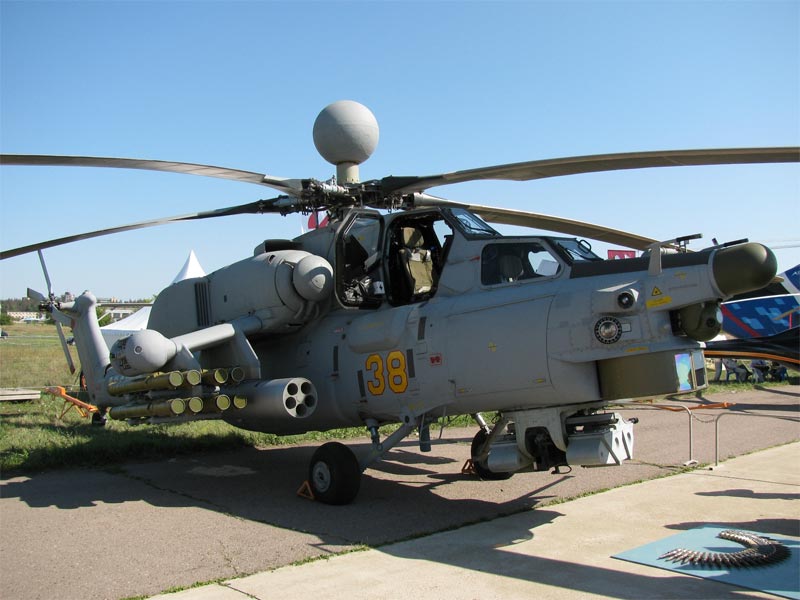
Dynamic circuit Mi-28N was the basis for the development of a cost center to them. ML Mile draft new helicopters air infantry fighting vehicle Mi-40 transport and passenger Mi-58.
Serial production . Given the positive results of joint state tests of the first prototype of the Mi-28N, the Government of the Russian Federation December 14, 1997 issued a decree on the completion of the Mi-28 and the beginning of series production at the Rostov Helicopter Plant. However, due to the difficult economic situation in the country to complete the construction of the first pre-Rostovites helicopter was only in March 2004, in the variant versions of the Mi-28N "Night Hunter" - the first helicopter Rostov assembly (board №02, later - 024) made the first flight March 24, 2004 Before the formal decision December 27, 2005 the first flight made the first production helicopter aboard №32.
Issued March 4, 2006 the State Commission opinion on the issue of the initial batch of Mi-28N was the official definition of "Rostvertol" to start serial production of the Mi-28N and units for the customer - to carry out their operation. In the same year, the first production "Night Hunter" began to arrive in the Russian Air Force and signed a contract to supply up to 2015 67 Mi-28N. Earlier media announced its plans until 2010 to put 50 of these machines. Overall, domestic demand is estimated at 300 Air Force "Night Hunter". Interest in acquiring helicopters war ministries have expressed a number of foreign countries.Every year, planned to supply the Armed Forces of Russia for ten Mi-28N. As of 2010 serial production is zavodoa "Rostvertol" in Rostov-on-Don.

Continuous assembly of Mi-28N at the plant "Rostvertol", probably in 2010 ( http://gunm.ru ).
Prehistory of the Mi-28 ( available until the publication of a separate article ):
to deepen the development of the project combat helicopter Mi-28 employees' Mil. ML Mile "under the leadership of MN Tishchenko started in 1972 December 16, 1976 the CPSU Central Committee and USSR Council of Ministers adopted a resolution on the development of a combat helicopter Mi-28. All work was headed by Deputy Chief Designer A. Ivanov, a leading designer in charge was appointed MVWeinberg. Finding the most rational appearance and work to improve the technical and flight performance of the helicopter carried out in collaboration with specialized research, development and flight testing organizations.
By the end of 1977 designers Mil. ML Mile completed preliminary design, and in 1979 the DB started working rotorcraft design and testing of the first experimental models of assemblies and systems. In August 1980 the government commission on military-industrial issues, familiarized himself with the development of future combat helicopter Mi-28, decided to build a research and experimental samples, without waiting for the approval of the final layout. Therefore, the first prototype of the Mi-28, collected in July 1982, modify the required level in the process of development and flight testing.
November 10, 1982 the crew of the lead test pilot plant GR Karapetyan and test navigator VV Tsygankova first new helicopter lifted off the ground, and on 19 December the same year - made the first flight in a circle. The helicopter arrived on joint comparative state tests, in September 1983, pilot production cost centers completed the assembly of the second flying prototype. It was used to test the weapons.
In 1986, the Mi-28 has successfully passed the main part of the program state tests, and the following year was followed by a government decree to launch serial production of the helicopter. Then Mil. ML Mile completed the construction of pre-prototype, called Mi-28A. The helicopter has been praised by both domestic and foreign experts. It meets its intended purpose and in many respects superior to all helicopters of the same class. Piloting and maneuvering characteristics are unique and provide a high degree of survivability in air combat. May 6, 1993 test pilot Karapetyan first performed on the Mi-28 "loop the loop", and a few days later - "barrel."
Total including Mi-28A in 1982-1991 gg built and flew four Mi-28.
Construction : single-rotor helicopter to the scheme with tail rotor, two GTE, tricycle landing gear and auxiliary wing. Fuselage-metal, semi-monocoque construction, includes nasal and central parts, as well as the tail and the keel beam. In the bow are two separate compartments armored cockpit, which placed a chair in front of the navigator-operator, and behind and above the pilot's seat. To improve the survivability of the helicopter and the survival of the crew cab body armor available, which includes a set of ceramic tiles glued to the frame of the forward fuselage. Mi-28N - the only helicopter in the world, equipped with side armor windows. The pilot and navigator divided armor fences. The door is the navigator on the left side, and a pilot - on the right. Doors and windows are equipped with mechanisms for emergency relief. When emergency escape doors booths under inflated special traps that protect the crew from hitting the chassis. Front down to the bow mounted on a stabilized platform surveillance and attack the station and the frame gun mount. Placed under the floor of the pilot units of electrical equipment and sighting-flight and navigation system. Reservation - completely plane-parallel glazing armor can withstand direct hits bullets up to 12.7 mm armor shells hit the cab stand 20 mm cannon "Volcano".
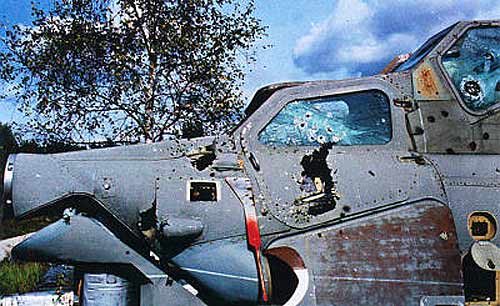
Cab Mi-28 after shooting of ZSU-23-4 "Shilka" (file photo Dmitri Mironov, Отечественная военная техника (после 1945 г.) • Главная страница ).
The rear compartment is roomy enough radio has free volumes, you can use it as a cargo (for transportation equipment at the airfield relocation or evacuation helicopter crew of another helicopter). Lower position of the tail boom excluded the possibility of tripping on her main rotor blade with a sharp maneuver. The rear of the keel beam is in the form of a fixed wheel. In the upper part of the keel beam stabilizer is attached. Under its lower part is the tail landing gear.

Open the rear compartment radio with free volumes. The Mi-28N board №12 Korenovsk Squadron airbase in Budennovsk, summer 2011 (http://4044415.livejournal.com ).
Passive protection system ensures the safety of the helicopter crew members during an emergency landing with a vertical speed of 12 m / s. The values are reduced to the level of congestion physiologically tolerable. Mechanisms operate system protection installed on the cylinder main landing gear shock absorbers. With their help, made drawdown energy absorbing crew seats and handles deviation forward pitch and roll control, which eliminates the possibility of injury to the pilot. Energogasyaschie chair "Pamir-K" design bureau "Zvezda", sinking 30 cm, protect the crew against overloads occurring during the emergency landing. In an emergency, and to compel the collapsible pilots pulling the back seat harness.
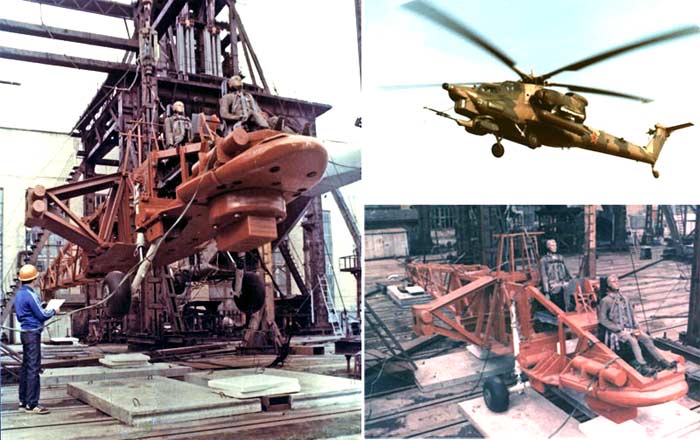
Stand for testing of passive protection of the Mi-28 ( http://mbp-c.com.ru ).
Cantilever wing with four pylons designed for suspension rocket, gunnery, bombing weapons and additional fuel tanks. At the ends of the wing fairings are located jamming device for shooting bullets. In an emergency, the wing can be reset. Stabilizer is connected to handle the collective pitch of the main rotor. five-blade main rotor. The blades are rectangular in plan. Spar blades - from polymeric composite materials forming the nose of the shape of the profile. To him attach the tail section, made in the form of cladding made of polymer composite materials with polymer-filler sotoplastovym. The main rotor hub is a titanium body with five handed down spherical elastomeric joints. In the movable joints and bushings are used metalfluoraplastic fabric bearings. The tail rotor chetyrehlopastnym.
To reduce noise and improve the efficiency designed for X-shaped pattern. Its sleeve consists of two modules arranged one above the other on the hub splines. Each module is a junction of the two arms of the blades. The blade is made up of black glass-stikovogo spar and the tail section of the cell block and the fiberglass skin. Main rotor and tail rotor equipped with electro-thermal anti-icing system. Chassis tricycle with a tail wheel. The design supports the main landing gear included hydropneumatic shock absorbers with additional emergency move. The device supports the main lever type allows you to change the clearance of the helicopter. The fuel system is in the form of two independent symmetric systems supply each engine with automatic cross-feeding and pumping. It consists of three tanks (two for each motor supplies, and one total) contained in the container of the fuel tank, the walls of which tested foam. Sami fuel tanks are filled with polyurethane foam which prevents the explosion. The transmission consists of a multi-threaded main gearbox VR-29, two bevel gear UR-28, which serve to transmit torque from the engine to the main gearbox, intermediate gear, gearbox and tail rotor transmission shaft drive.The control system - Booster consists of four mounted on the main gearbox combined steering drives that perform the functions of servo and steering gears autopilot.
Control of the helicopter maximum skompleksirovano: in the cockpit flight controls are located in the navigator-operator - control arms. The hydraulic system consists of two independent systems for combined power steering gears and hydraulic dampers. The electrical system is AC powered by two generators driven by the main gearbox. The hydraulic system consists of two independent systems used to supply the combined steering gear control systems and hydraulic damper in the directional control. Life support system includes an air conditioning system and oxygen equipment.
Test . The first experimental helicopter Mi-28N was built in August 1996 and made its first flight 14 November 1997 (test pilot and navigator V.V.Yudin S.V.Nikulin), and on April 30, 1997 began to pass the factory flight tests. Four years later, the Mi-28N entered the state joint tests (2001). Given the high demand for military vehicles of this type, the command of the Russian Air Force in 2002, took the Mi-28N as the main combat helicopter promising future, without waiting for the completion of the test.In June 2005, the program has begun testing the second prototype prototype of the Mi-28N. March 4, 2006 after the successful completion of the first phase of the state joint tests the state commission chaired by Chief of the Russian Air Force, Army General V.S.Mihaylova issued a conclusion on the issue of the initial batch of Mi-28N. In May 2006, state tests to join the first serial Mi-28N board №32. State joint tests of the Mi-28N completed December 26, 2008 signing of the act on their end. At GSI participated 2 experienced and 7 pre helicopters. October 15, 2009 order of the President of the Russian Mi-28N officially adopted for use as the primary attack helicopter.

Mi-28N and 10 onboard №№09 yellow, summer 2012 (photo - A.Blogin, http://ruforces-com.livejournal.com ). Mi-28N built in 2012 at the airport by "Rostvertol" Rostov-on-Don, March 9, 2012 (photo - Michael Mizikaev, ✈ russianplanes.net ✈ наша авиация ). The first prototype of the Mi-28N - OP-1 helicopter, board №014 after modifications to the air show MAKS-2003 , 23.08.2003 (photo - Flavien Breitenmoser,http://www.airliners.net ). The Mi-28N - a prototype of the Mi-28NE participated in the demonstration flights in India at MAKS-2011 August 16-21, 2011 . (photo - VLAS, Отечественная военная техника (после 1945 г.) • Главная страница ).



Dynamic circuit Mi-28N was the basis for the development of a cost center to them. ML Mile draft new helicopters air infantry fighting vehicle Mi-40 transport and passenger Mi-58.
Serial production . Given the positive results of joint state tests of the first prototype of the Mi-28N, the Government of the Russian Federation December 14, 1997 issued a decree on the completion of the Mi-28 and the beginning of series production at the Rostov Helicopter Plant. However, due to the difficult economic situation in the country to complete the construction of the first pre-Rostovites helicopter was only in March 2004, in the variant versions of the Mi-28N "Night Hunter" - the first helicopter Rostov assembly (board №02, later - 024) made the first flight March 24, 2004 Before the formal decision December 27, 2005 the first flight made the first production helicopter aboard №32.
Issued March 4, 2006 the State Commission opinion on the issue of the initial batch of Mi-28N was the official definition of "Rostvertol" to start serial production of the Mi-28N and units for the customer - to carry out their operation. In the same year, the first production "Night Hunter" began to arrive in the Russian Air Force and signed a contract to supply up to 2015 67 Mi-28N. Earlier media announced its plans until 2010 to put 50 of these machines. Overall, domestic demand is estimated at 300 Air Force "Night Hunter". Interest in acquiring helicopters war ministries have expressed a number of foreign countries.Every year, planned to supply the Armed Forces of Russia for ten Mi-28N. As of 2010 serial production is zavodoa "Rostvertol" in Rostov-on-Don.

Continuous assembly of Mi-28N at the plant "Rostvertol", probably in 2010 ( http://gunm.ru ).
Prehistory of the Mi-28 ( available until the publication of a separate article ):
to deepen the development of the project combat helicopter Mi-28 employees' Mil. ML Mile "under the leadership of MN Tishchenko started in 1972 December 16, 1976 the CPSU Central Committee and USSR Council of Ministers adopted a resolution on the development of a combat helicopter Mi-28. All work was headed by Deputy Chief Designer A. Ivanov, a leading designer in charge was appointed MVWeinberg. Finding the most rational appearance and work to improve the technical and flight performance of the helicopter carried out in collaboration with specialized research, development and flight testing organizations.
By the end of 1977 designers Mil. ML Mile completed preliminary design, and in 1979 the DB started working rotorcraft design and testing of the first experimental models of assemblies and systems. In August 1980 the government commission on military-industrial issues, familiarized himself with the development of future combat helicopter Mi-28, decided to build a research and experimental samples, without waiting for the approval of the final layout. Therefore, the first prototype of the Mi-28, collected in July 1982, modify the required level in the process of development and flight testing.
November 10, 1982 the crew of the lead test pilot plant GR Karapetyan and test navigator VV Tsygankova first new helicopter lifted off the ground, and on 19 December the same year - made the first flight in a circle. The helicopter arrived on joint comparative state tests, in September 1983, pilot production cost centers completed the assembly of the second flying prototype. It was used to test the weapons.
In 1986, the Mi-28 has successfully passed the main part of the program state tests, and the following year was followed by a government decree to launch serial production of the helicopter. Then Mil. ML Mile completed the construction of pre-prototype, called Mi-28A. The helicopter has been praised by both domestic and foreign experts. It meets its intended purpose and in many respects superior to all helicopters of the same class. Piloting and maneuvering characteristics are unique and provide a high degree of survivability in air combat. May 6, 1993 test pilot Karapetyan first performed on the Mi-28 "loop the loop", and a few days later - "barrel."
Total including Mi-28A in 1982-1991 gg built and flew four Mi-28.
Construction : single-rotor helicopter to the scheme with tail rotor, two GTE, tricycle landing gear and auxiliary wing. Fuselage-metal, semi-monocoque construction, includes nasal and central parts, as well as the tail and the keel beam. In the bow are two separate compartments armored cockpit, which placed a chair in front of the navigator-operator, and behind and above the pilot's seat. To improve the survivability of the helicopter and the survival of the crew cab body armor available, which includes a set of ceramic tiles glued to the frame of the forward fuselage. Mi-28N - the only helicopter in the world, equipped with side armor windows. The pilot and navigator divided armor fences. The door is the navigator on the left side, and a pilot - on the right. Doors and windows are equipped with mechanisms for emergency relief. When emergency escape doors booths under inflated special traps that protect the crew from hitting the chassis. Front down to the bow mounted on a stabilized platform surveillance and attack the station and the frame gun mount. Placed under the floor of the pilot units of electrical equipment and sighting-flight and navigation system. Reservation - completely plane-parallel glazing armor can withstand direct hits bullets up to 12.7 mm armor shells hit the cab stand 20 mm cannon "Volcano".

Cab Mi-28 after shooting of ZSU-23-4 "Shilka" (file photo Dmitri Mironov, Отечественная военная техника (после 1945 г.) • Главная страница ).
The rear compartment is roomy enough radio has free volumes, you can use it as a cargo (for transportation equipment at the airfield relocation or evacuation helicopter crew of another helicopter). Lower position of the tail boom excluded the possibility of tripping on her main rotor blade with a sharp maneuver. The rear of the keel beam is in the form of a fixed wheel. In the upper part of the keel beam stabilizer is attached. Under its lower part is the tail landing gear.

Open the rear compartment radio with free volumes. The Mi-28N board №12 Korenovsk Squadron airbase in Budennovsk, summer 2011 (http://4044415.livejournal.com ).
Passive protection system ensures the safety of the helicopter crew members during an emergency landing with a vertical speed of 12 m / s. The values are reduced to the level of congestion physiologically tolerable. Mechanisms operate system protection installed on the cylinder main landing gear shock absorbers. With their help, made drawdown energy absorbing crew seats and handles deviation forward pitch and roll control, which eliminates the possibility of injury to the pilot. Energogasyaschie chair "Pamir-K" design bureau "Zvezda", sinking 30 cm, protect the crew against overloads occurring during the emergency landing. In an emergency, and to compel the collapsible pilots pulling the back seat harness.

Stand for testing of passive protection of the Mi-28 ( http://mbp-c.com.ru ).
Cantilever wing with four pylons designed for suspension rocket, gunnery, bombing weapons and additional fuel tanks. At the ends of the wing fairings are located jamming device for shooting bullets. In an emergency, the wing can be reset. Stabilizer is connected to handle the collective pitch of the main rotor. five-blade main rotor. The blades are rectangular in plan. Spar blades - from polymeric composite materials forming the nose of the shape of the profile. To him attach the tail section, made in the form of cladding made of polymer composite materials with polymer-filler sotoplastovym. The main rotor hub is a titanium body with five handed down spherical elastomeric joints. In the movable joints and bushings are used metalfluoraplastic fabric bearings. The tail rotor chetyrehlopastnym.
To reduce noise and improve the efficiency designed for X-shaped pattern. Its sleeve consists of two modules arranged one above the other on the hub splines. Each module is a junction of the two arms of the blades. The blade is made up of black glass-stikovogo spar and the tail section of the cell block and the fiberglass skin. Main rotor and tail rotor equipped with electro-thermal anti-icing system. Chassis tricycle with a tail wheel. The design supports the main landing gear included hydropneumatic shock absorbers with additional emergency move. The device supports the main lever type allows you to change the clearance of the helicopter. The fuel system is in the form of two independent symmetric systems supply each engine with automatic cross-feeding and pumping. It consists of three tanks (two for each motor supplies, and one total) contained in the container of the fuel tank, the walls of which tested foam. Sami fuel tanks are filled with polyurethane foam which prevents the explosion. The transmission consists of a multi-threaded main gearbox VR-29, two bevel gear UR-28, which serve to transmit torque from the engine to the main gearbox, intermediate gear, gearbox and tail rotor transmission shaft drive.The control system - Booster consists of four mounted on the main gearbox combined steering drives that perform the functions of servo and steering gears autopilot.
Control of the helicopter maximum skompleksirovano: in the cockpit flight controls are located in the navigator-operator - control arms. The hydraulic system consists of two independent systems for combined power steering gears and hydraulic dampers. The electrical system is AC powered by two generators driven by the main gearbox. The hydraulic system consists of two independent systems used to supply the combined steering gear control systems and hydraulic damper in the directional control. Life support system includes an air conditioning system and oxygen equipment.


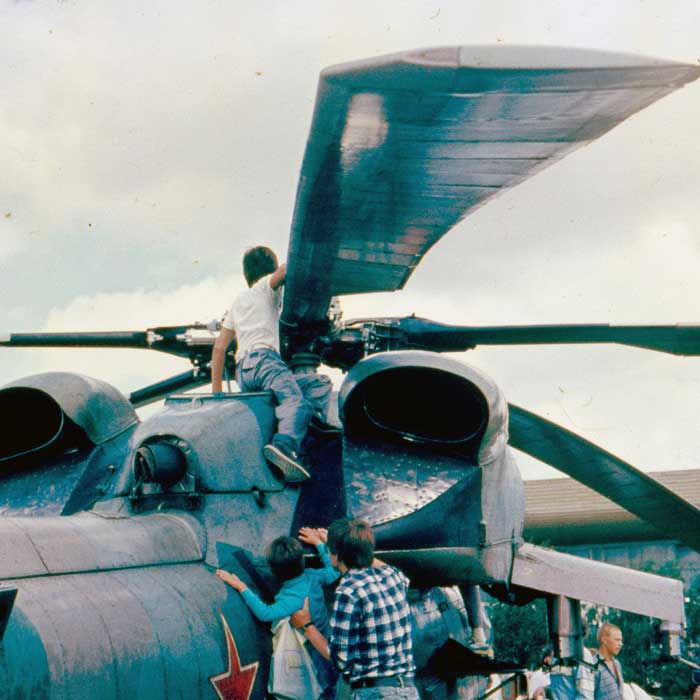
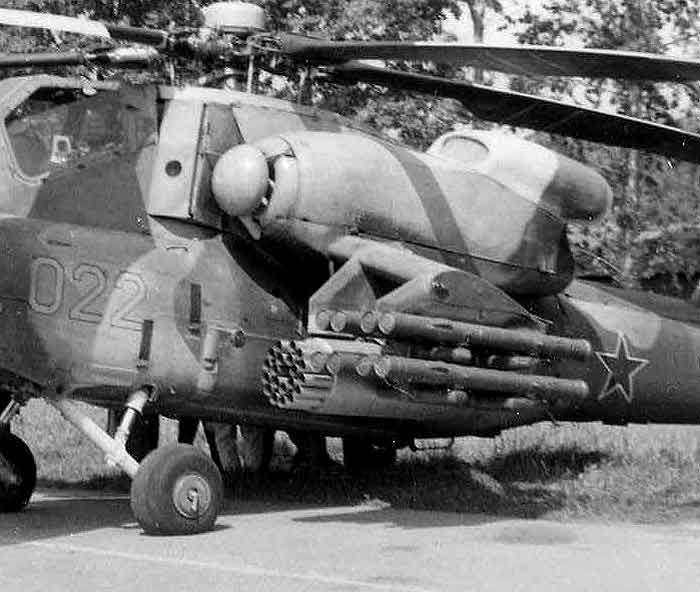


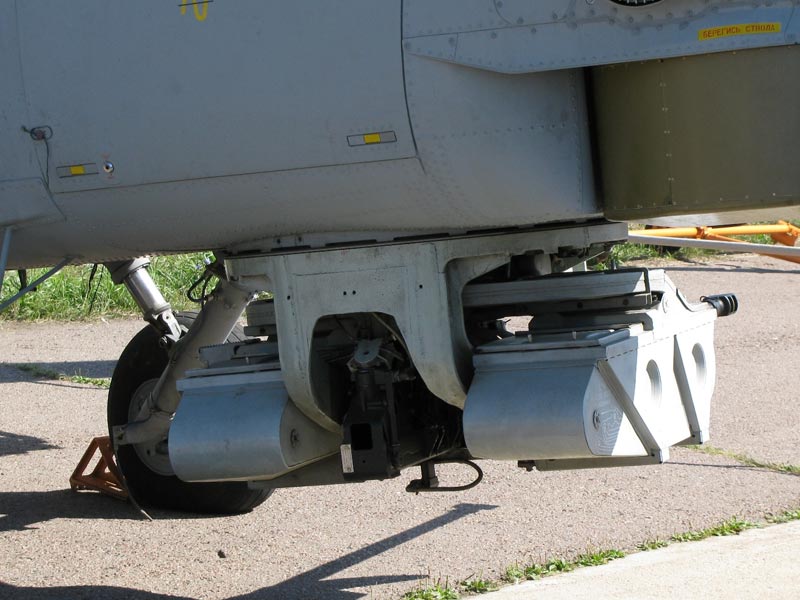
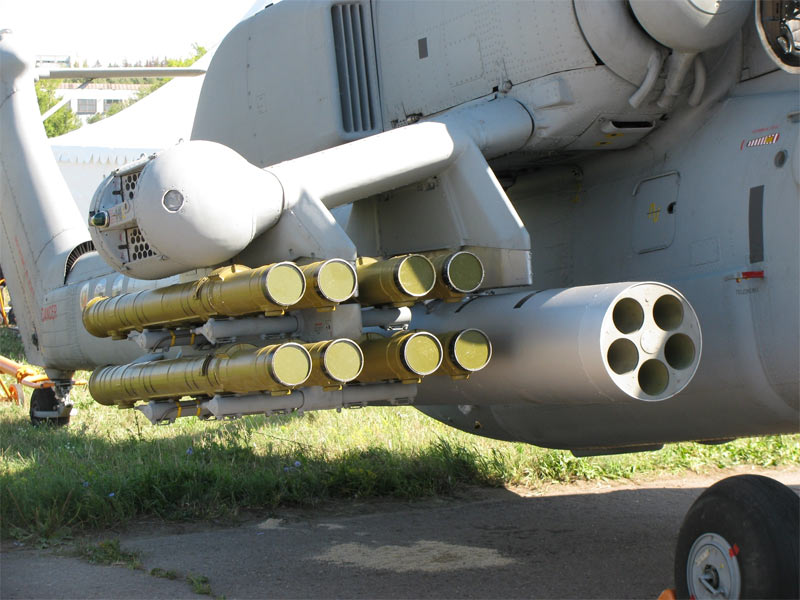
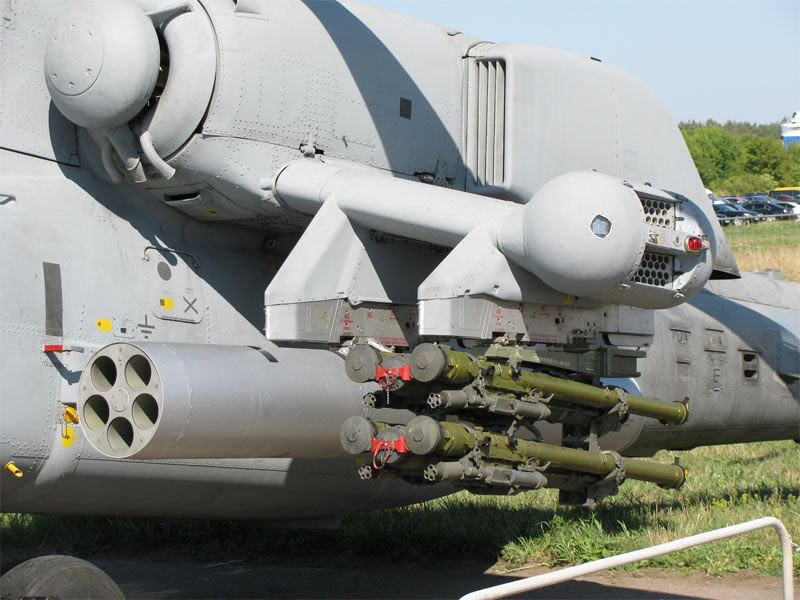
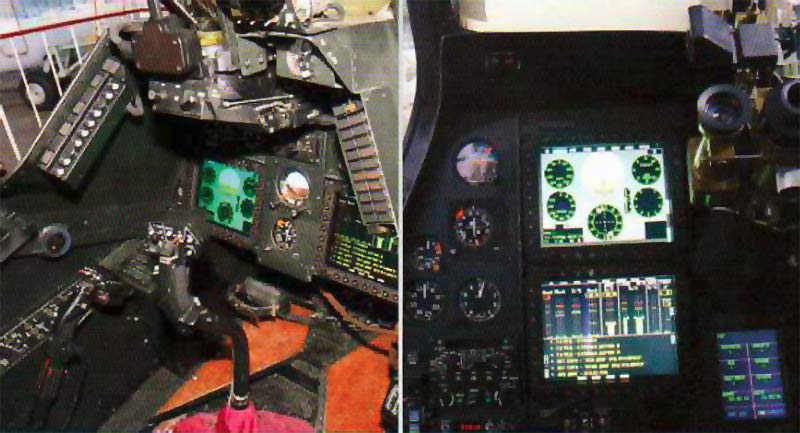

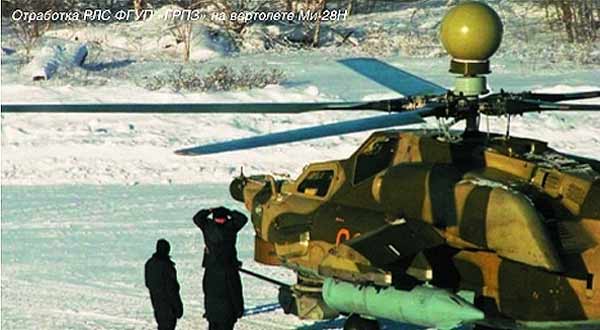


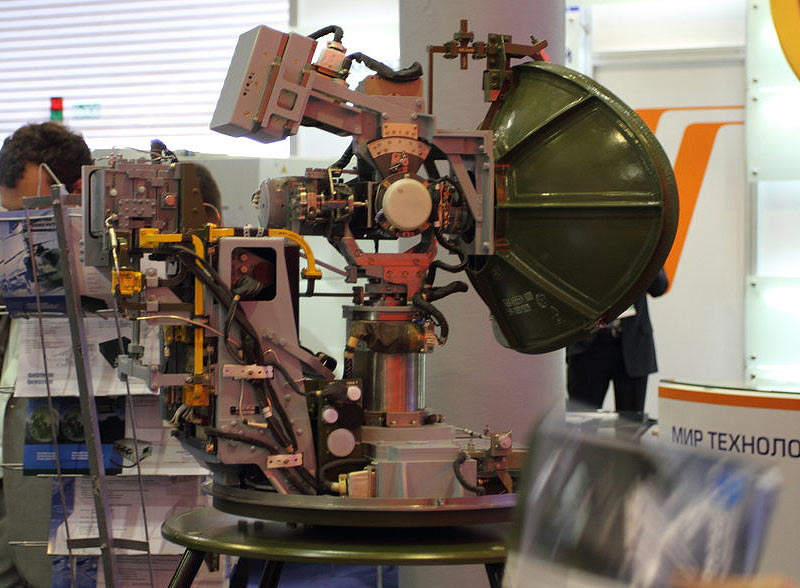



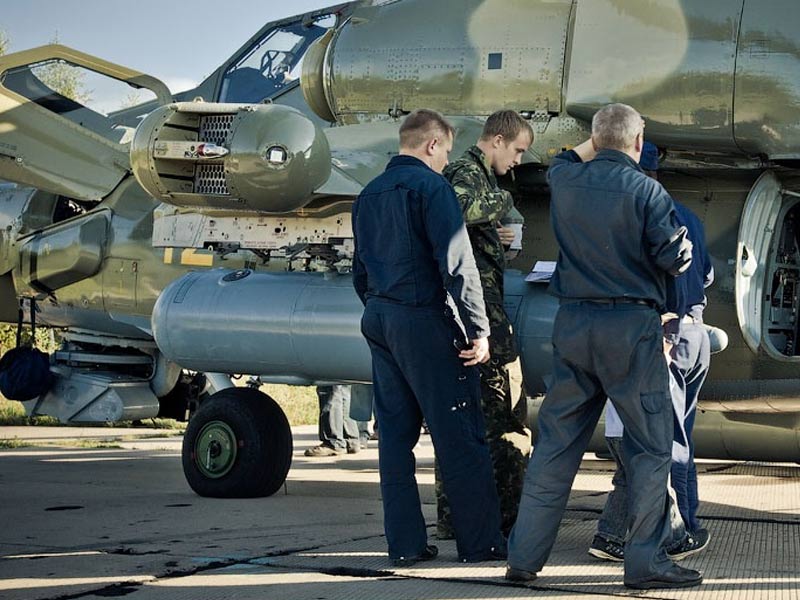
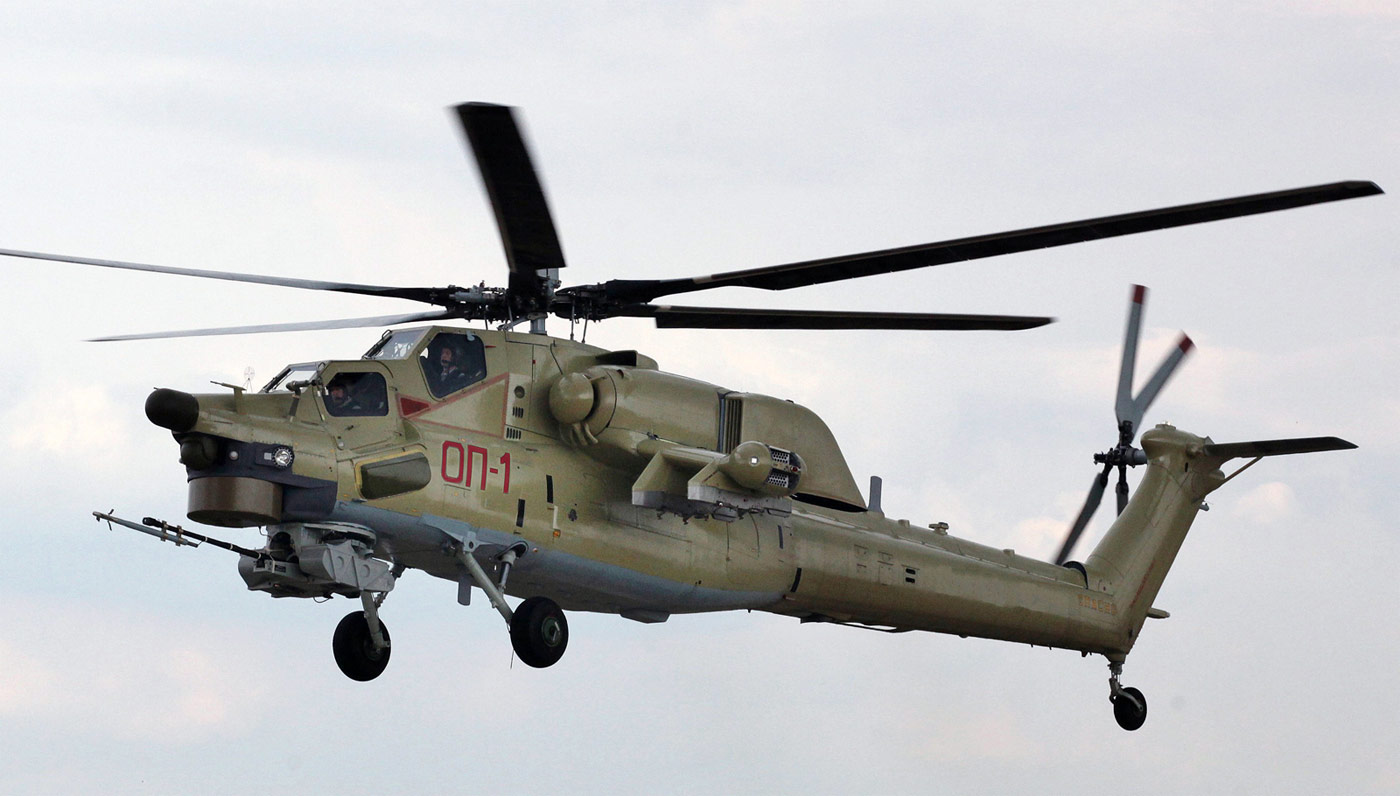
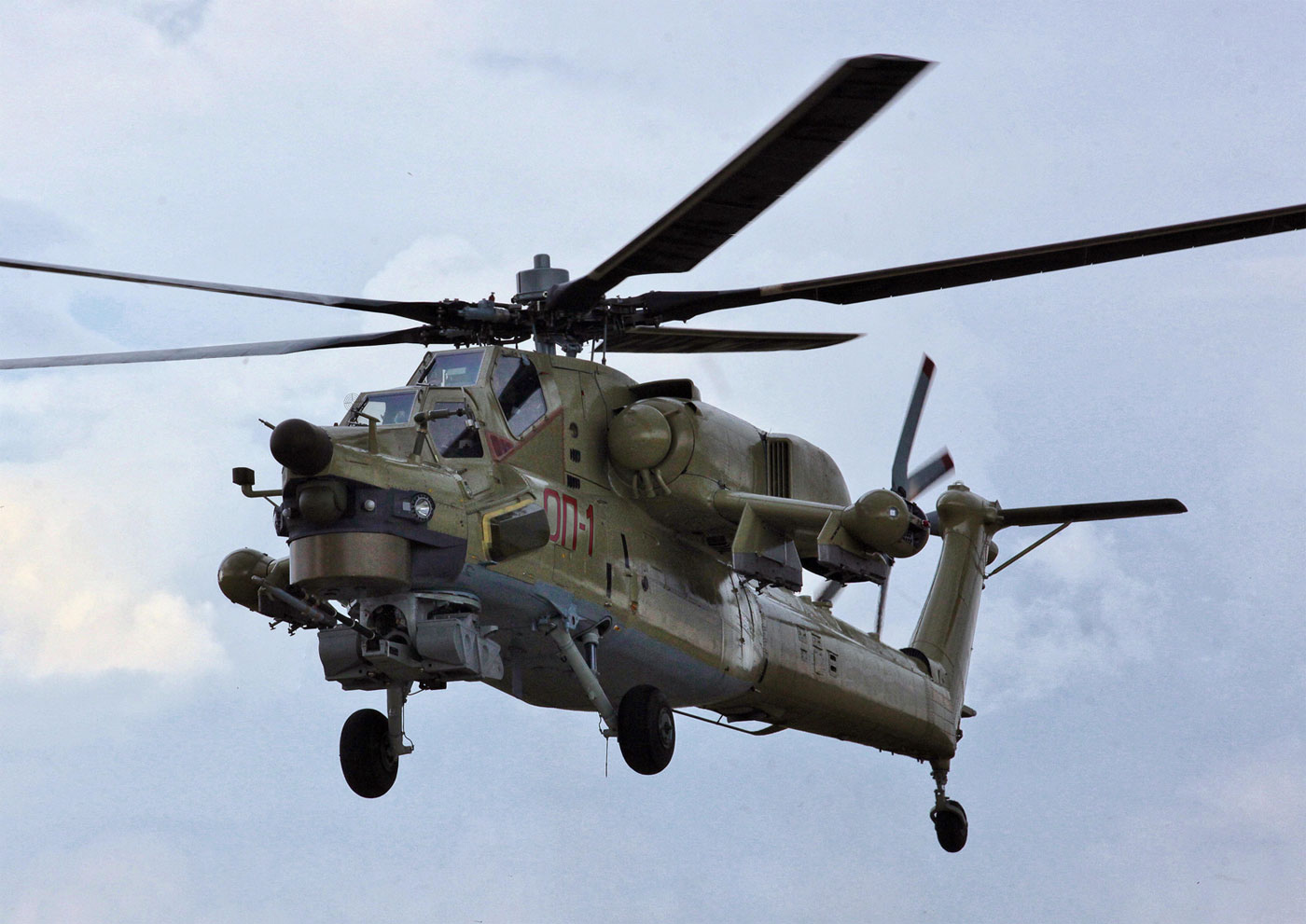

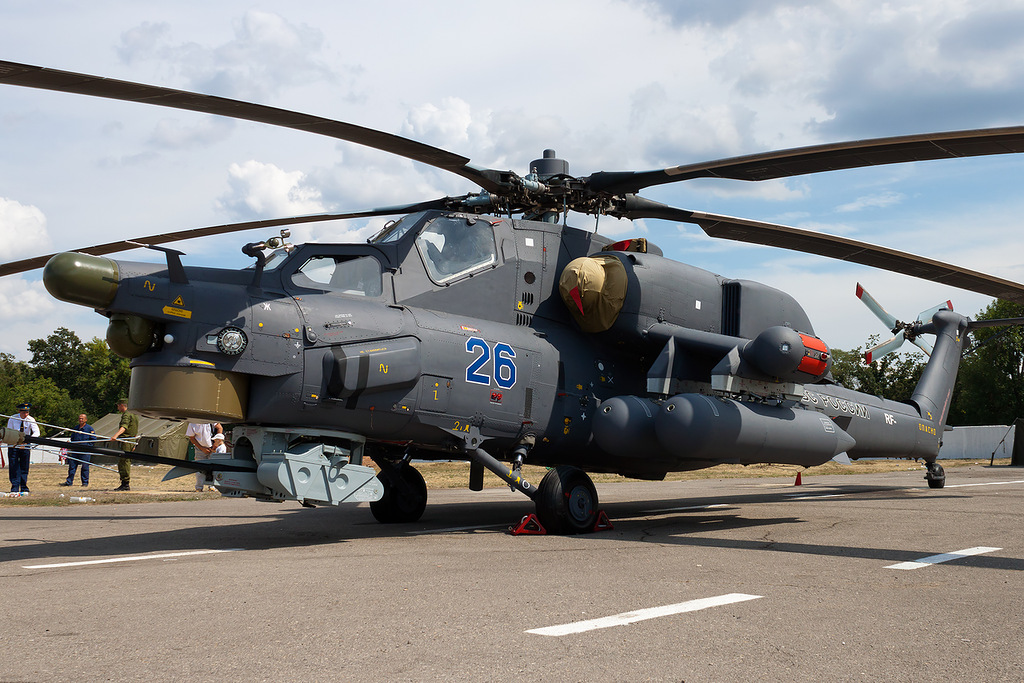
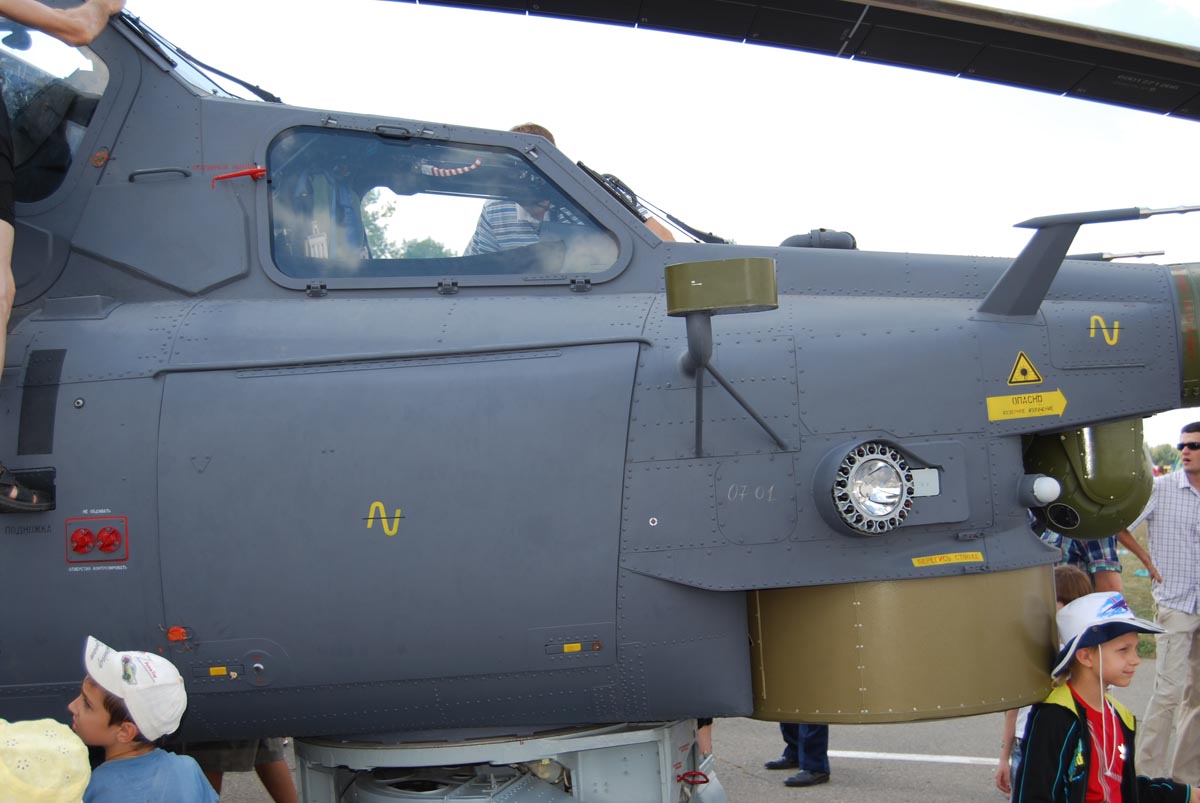



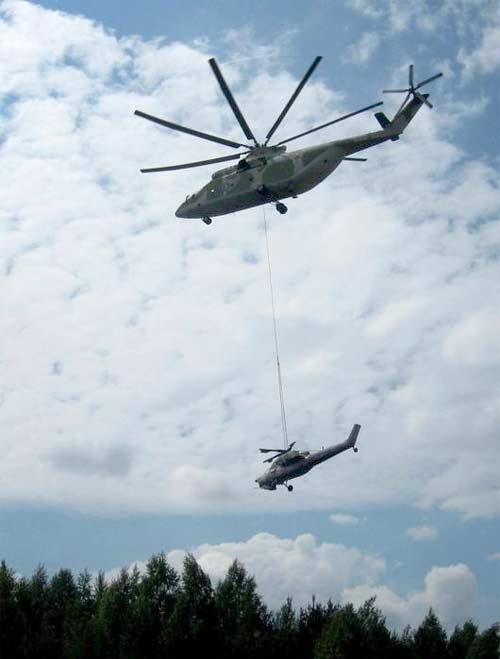
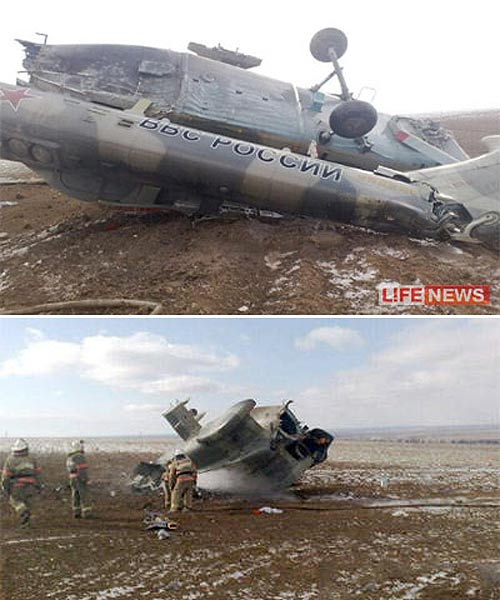
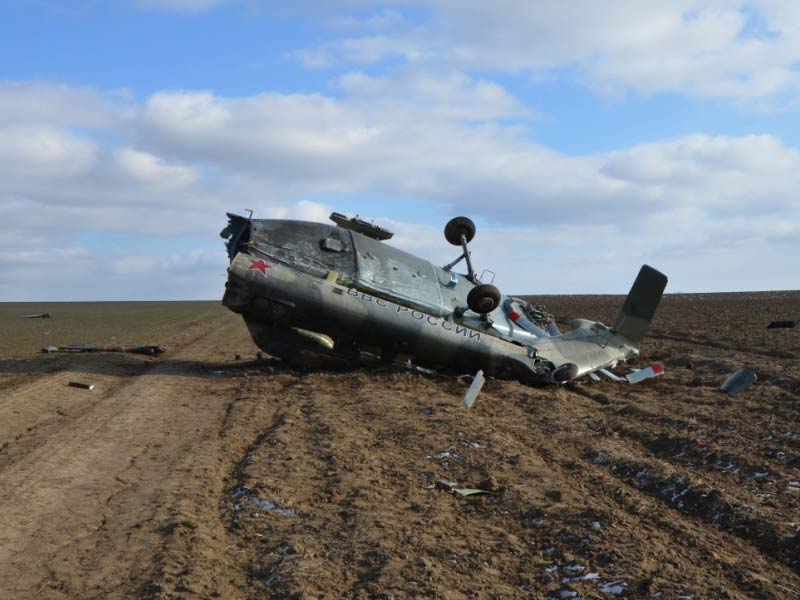




 ! If I wanted to read the article, I'd have clicked on it. I don't want my inbox filled with tag alerts. Shameful wh**ing for views.
! If I wanted to read the article, I'd have clicked on it. I don't want my inbox filled with tag alerts. Shameful wh**ing for views.


